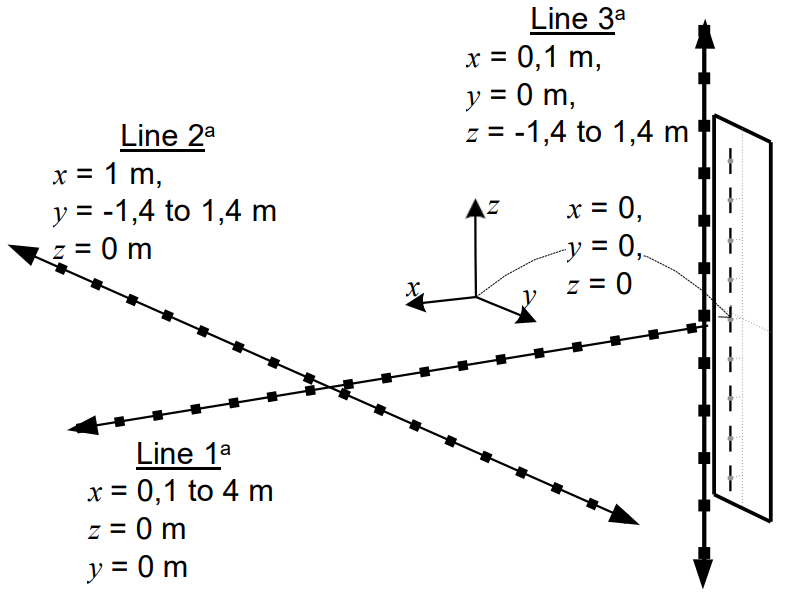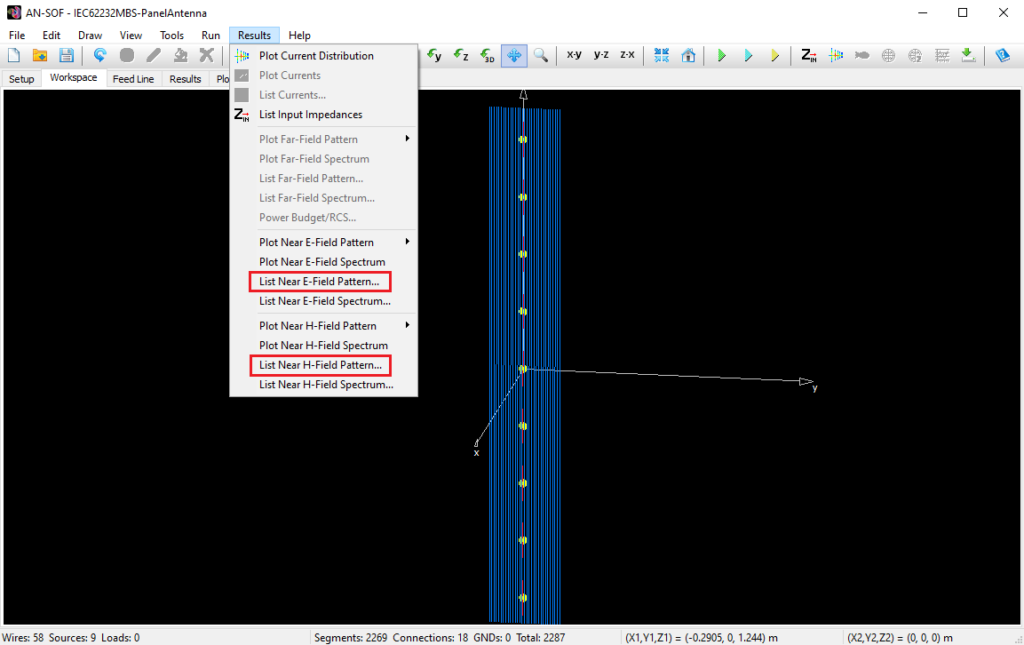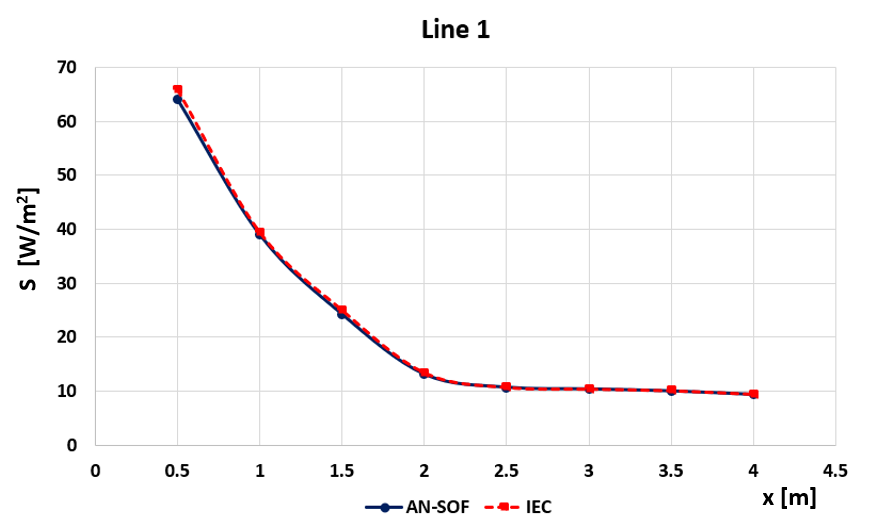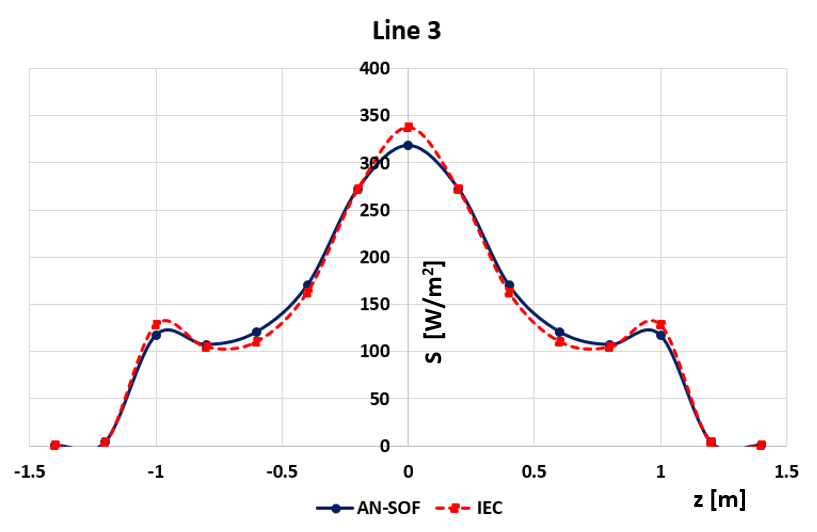Search for answers or browse our Knowledge Base.
Guides | Models | Validation | Blog
Validating Panel RBS Antenna with Dipole Radiators against IEC 62232
The IEC FDIS 62232 is a standard published by the International Electrotechnical Commission (IEC) that provides methods for determining radio-frequency field strength and specific absorption rate (SAR) in the vicinity of radiocommunication base stations (RBS) for the purpose of evaluating human exposure.
This article validates the results obtained from AN-SOF by replicating a panel antenna model with nine dipole radiators. The model used for validation was published by the IEC and an excerpt of the document can be accessed by following this link >. The antenna operates at 900 MHz, and each dipole is fed by a source with an amplitude that varies depending on the position of the dipole in the array. The total power delivered by the sources is 80 W, and this input power can be entered in AN-SOF in the Setup tab under the Excitation panel > (see Fig. 1).

The near electric and magnetic fields of the antenna are calculated along three different lines, as shown in Figure 2 from the IEC document >. To calculate the fields along these lines, the coordinates of the points have been entered in the Near-Field panel > in AN-SOF, as illustrated in Figure 3.


The IEC document provides the power density along these three lines, and it has been established that a simulation package passes validation if the maximum deviation from the reference results is less than 10%.
As all the dipoles in the panel are oriented vertically, the radiated field will have a vertical polarization. Therefore, the reflector panel has been modeled in AN-SOF using a series of closely spaced vertical wires, as illustrated in Figure 4. To achieve the best fit with the published data, 31 wires have been used, divided into 70 segments each, and with a radius of 0.1 mm.

The symmetry of the dipole array allows us to infer that the near electric field will consist of two components, Ex and Ez, while the near magnetic field will only have the Hy component. The complex power density is obtained through the vector product S = E x H* (rms values). Therefore, S will have two components, Sx = -Ez Hy* and Sz = Ex Hy*. The time average of S = |S| is the observable power density, i.e. S2 = |Sx|2 + |Sz|2 = (|Ex|2 + |Ez|2) |Hy|2. Consequently, S = |Etot| |Htot|. AN-SOF calculates the rms values of the total fields, |Etot| and |Htot|. To obtain the power density, it is simply a matter of multiplying these two values together.
The AN-SOF model of the reflector panel with nine dipoles is available for download via this link >.
The following section of this article will present a comparison between the results obtained from AN-SOF and those published by the IEC.
It should be noted that for all three lines, a deviation of less than 10% was obtained. Notably, lines 1 and 2 exhibit a remarkable fit to the published values. In the case of line 3, it is understandable that a greater deviation was observed due to its closer proximity to the panel.
| X | Y | Z | E-total | H-total | AN-SOF | IEC | Diff. |
|---|---|---|---|---|---|---|---|
| m | m | m | V/m | A/m | W/m² | W/m² | % |
| 0.5 | 0 | 0 | 155.074 | 0.412729 | 64.00 | 65.8 | -2.7% |
| 1 | 0 | 0 | 119.666 | 0.325305 | 38.93 | 39.4 | -1.2% |
| 1.5 | 0 | 0 | 94.964 | 0.254813 | 24.20 | 25 | -3.2% |
| 2 | 0 | 0 | 70.7595 | 0.184971 | 13.09 | 13.4 | -2.3% |
| 2.5 | 0 | 0 | 63.6891 | 0.167708 | 10.68 | 10.7 | -0.2% |
| 3 | 0 | 0 | 62.4638 | 0.165975 | 10.37 | 10.4 | -0.3% |
| 3.5 | 0 | 0 | 61.2374 | 0.163288 | 10.00 | 10.1 | -1.0% |
| 4 | 0 | 0 | 59.1723 | 0.157916 | 9.34 | 9.44 | -1.0% |

| X | Y | Z | E-total | H-total | AN-SOF | IEC | Diff. |
|---|---|---|---|---|---|---|---|
| m | m | m | V/m | A/m | W/m² | W/m² | % |
| 1 | -1.4 | 0 | 48.8217 | 0.129096 | 6.30 | 6.22 | 1.3% |
| 1 | -1.2 | 0 | 58.5661 | 0.156657 | 9.17 | 9.16 | 0.2% |
| 1 | -1 | 0 | 70.4692 | 0.1908 | 13.45 | 13.6 | -1.1% |
| 1 | -0.8 | 0 | 83.6555 | 0.228627 | 19.13 | 19.6 | -2.4% |
| 1 | -0.6 | 0 | 96.8014 | 0.265566 | 25.71 | 26.3 | -2.3% |
| 1 | -0.4 | 0 | 108.374 | 0.296696 | 32.15 | 32.8 | -2.0% |
| 1 | -0.2 | 0 | 116.617 | 0.317764 | 37.06 | 37.6 | -1.4% |
| 1 | 0 | 0 | 119.666 | 0.325305 | 38.93 | 39.4 | -1.2% |
| 1 | 0.2 | 0 | 116.617 | 0.317764 | 37.06 | 37.6 | -1.4% |
| 1 | 0.4 | 0 | 108.374 | 0.296696 | 32.15 | 32.8 | -2.0% |
| 1 | 0.6 | 0 | 96.8014 | 0.265566 | 25.71 | 26.3 | -2.3% |
| 1 | 0.8 | 0 | 83.6555 | 0.228627 | 19.13 | 19.6 | -2.4% |
| 1 | 1 | 0 | 70.4692 | 0.1908 | 13.45 | 13.6 | -1.1% |
| 1 | 1.2 | 0 | 58.5661 | 0.156657 | 9.17 | 9.16 | 0.2% |
| 1 | 1.4 | 0 | 48.8217 | 0.129096 | 6.30 | 6.22 | 1.3% |

| X | Y | Z | E-total | H-total | AN-SOF | IEC | Diff. |
|---|---|---|---|---|---|---|---|
| m | m | m | V/m | A/m | W/m² | W/m² | % |
| 0.1 | 0 | -1.4 | 9.96564 | 0.017827 | 0.18 | 0.173 | 2.7% |
| 0.1 | 0 | -1.2 | 48.9676 | 0.084127 | 4.12 | 3.77 | 9.3% |
| 0.1 | 0 | -1 | 197.953 | 0.592068 | 117.20 | 129 | -9.1% |
| 0.1 | 0 | -0.8 | 201.218 | 0.532155 | 107.08 | 105 | 2.0% |
| 0.1 | 0 | -0.6 | 225.774 | 0.535084 | 120.81 | 111 | 8.8% |
| 0.1 | 0 | -0.4 | 268.064 | 0.634264 | 170.02 | 163 | 4.3% |
| 0.1 | 0 | -0.2 | 318.386 | 0.855277 | 272.31 | 272 | 0.1% |
| 0.1 | 0 | 0 | 337.213 | 0.944083 | 318.36 | 338 | -5.8% |
| 0.1 | 0 | 0.2 | 318.386 | 0.855277 | 272.31 | 272 | 0.1% |
| 0.1 | 0 | 0.4 | 268.064 | 0.634264 | 170.02 | 163 | 4.3% |
| 0.1 | 0 | 0.6 | 225.774 | 0.535084 | 120.81 | 111 | 8.8% |
| 0.1 | 0 | 0.8 | 201.218 | 0.532155 | 107.08 | 105 | 2.0% |
| 0.1 | 0 | 1 | 197.953 | 0.592068 | 117.20 | 129 | -9.1% |
| 0.1 | 0 | 1.2 | 48.9676 | 0.084127 | 4.12 | 3.77 | 9.3% |
| 0.1 | 0 | 1.4 | 9.96564 | 0.017827 | 0.18 | 0.173 | 2.7% |

This validation example serves as evidence that AN-SOF can provide highly accurate results with a relatively simple model.
